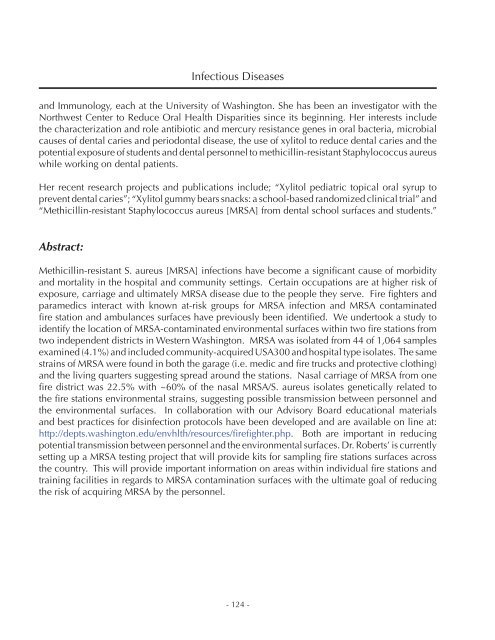Redmond EMS Abstracts.indd - IAFF
Redmond EMS Abstracts.indd - IAFF
Redmond EMS Abstracts.indd - IAFF
You also want an ePaper? Increase the reach of your titles
YUMPU automatically turns print PDFs into web optimized ePapers that Google loves.
Infectious Diseases<br />
and Immunology, each at the University of Washington. She has been an investigator with the<br />
Northwest Center to Reduce Oral Health Disparities since its beginning. Her interests include<br />
the characterization and role antibiotic and mercury resistance genes in oral bacteria, microbial<br />
causes of dental caries and periodontal disease, the use of xylitol to reduce dental caries and the<br />
potential exposure of students and dental personnel to methicillin-resistant Staphylococcus aureus<br />
while working on dental patients.<br />
Her recent research projects and publications include; “Xylitol pediatric topical oral syrup to<br />
prevent dental caries”; “Xylitol gummy bears snacks: a school-based randomized clinical trial” and<br />
“Methicillin-resistant Staphylococcus aureus [MRSA] from dental school surfaces and students.”<br />
Abstract:<br />
Methicillin-resistant S. aureus [MRSA] infections have become a significant cause of morbidity<br />
and mortality in the hospital and community settings. Certain occupations are at higher risk of<br />
exposure, carriage and ultimately MRSA disease due to the people they serve. Fire fighters and<br />
paramedics interact with known at-risk groups for MRSA infection and MRSA contaminated<br />
fire station and ambulances surfaces have previously been identified. We undertook a study to<br />
identify the location of MRSA-contaminated environmental surfaces within two fire stations from<br />
two independent districts in Western Washington. MRSA was isolated from 44 of 1,064 samples<br />
examined (4.1%) and included community-acquired USA300 and hospital type isolates. The same<br />
strains of MRSA were found in both the garage (i.e. medic and fire trucks and protective clothing)<br />
and the living quarters suggesting spread around the stations. Nasal carriage of MRSA from one<br />
fire district was 22.5% with ~60% of the nasal MRSA/S. aureus isolates genetically related to<br />
the fire stations environmental strains, suggesting possible transmission between personnel and<br />
the environmental surfaces. In collaboration with our Advisory Board educational materials<br />
and best practices for disinfection protocols have been developed and are available on line at:<br />
http://depts.washington.edu/envhlth/resources/firefighter.php. Both are important in reducing<br />
potential transmission between personnel and the environmental surfaces. Dr. Roberts’ is currently<br />
setting up a MRSA testing project that will provide kits for sampling fire stations surfaces across<br />
the country. This will provide important information on areas within individual fire stations and<br />
training facilities in regards to MRSA contamination surfaces with the ultimate goal of reducing<br />
the risk of acquiring MRSA by the personnel.<br />
- 124 -

















